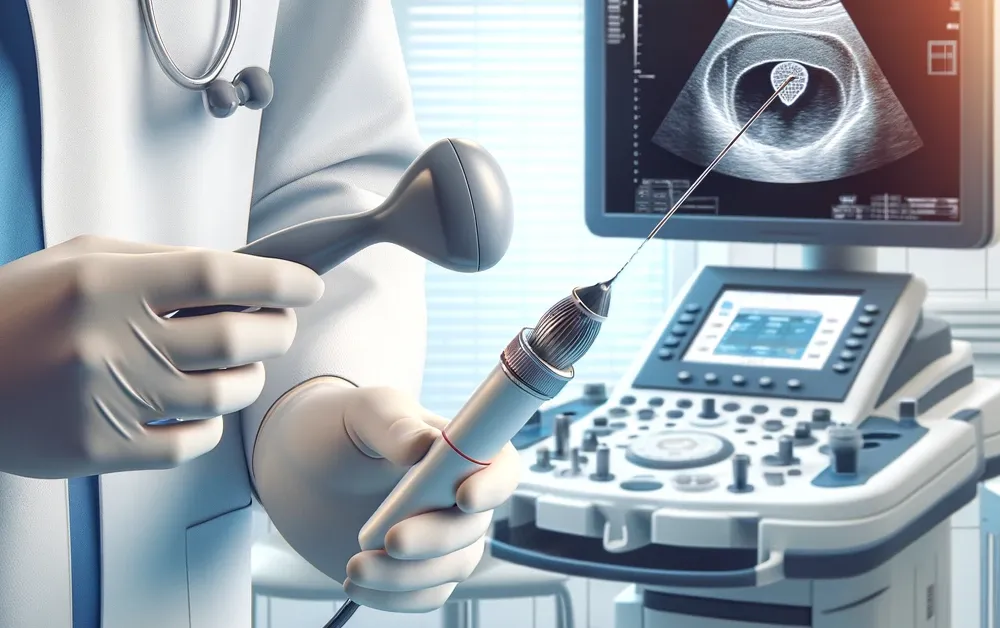Prostate Biopsy


What is Prostate Biopsy
A prostate biopsy is a medical procedure performed to detect prostate cancer. The process involves collecting prostate tissue samples from the area surrounding the suspected tumour for pathology analysis.
The procedure is recommended when results from other tests, such as a prostate-specific antigen (PSA) blood test or an MRI, suggest the possibility of cancer.
By examining the tissue samples under a microscope, pathologists can determine the presence of cancerous cells and provide information regarding their aggressiveness and extent.
Indications for Prostate Biopsy
A prostate biopsy is conducted when certain indicators suggest the potential presence of prostate cancer.
Elevated PSA Levels
Prostate-specific antigen (PSA) is a protein produced by prostate cells. Elevated levels of PSA in the blood can be an indicator of prostate cancer, though high PSA can also be caused by other conditions such as prostatitis or benign prostatic hyperplasia.
Abnormal MRI Scan
A suspicious MRI scan of the prostate may prompt a biopsy to confirm the presence of cancerous cells, particularly in cases where other tests are inconclusive.
Active Surveillance of Prostate Cancer
In cases where the patient is already diagnosed with prostate cancer, biopsies may be conducted periodically to monitor the progression of the disease.
Types of Prostate Biopsy
When conducting a prostate biopsy, several techniques can be employed, each with specific methodologies and advantages. The three main types are:
Transrectal Ultrasound (TRUS) Guided Biopsy
This is the most common method. Using ultrasound guidance, a thin needle is inserted through the rectal wall into the prostate gland to collect tissue samples. The ultrasound provides real-time images, allowing the accurate targeting of areas of concern within the prostate.
Transperineal Ultrasound Guided Biopsy
In this approach, the biopsy needle is inserted through the skin between the anus and scrotum (the perineum). This method, also using ultrasound guidance, reduces the risk of certain complications, such as infection. It can be beneficial for patients with anatomical issues that make TRUS-guided biopsy challenging.
MRI-Guided Biopsy
MRI-guided biopsy combines MRI scans with real-time ultrasound imaging to accurately target suspicious areas within the prostate. It is useful for targeting areas that may be missed by traditional TRUS biopsy, offering a higher level of precision in detecting prostate cancers.
Prostate Biopsy Procedure
The process generally involves the following steps, although specifics may vary depending on the type of biopsy being performed:
- Anaesthesia: Local anaesthesia can be used to minimise discomfort during the biopsy.
- Biopsy Technique: In a TRUS-guided biopsy, a probe is inserted into the rectum to image the prostate and guide needle insertion. In a transperineal biopsy, the needle is inserted through the perineum. In an MRI-guided biopsy, MRI images are used in conjunction with real-time ultrasound.
- Tissue Sample Collection: Several small tissue samples are collected from different areas of the prostate gland. This process is usually quick, typically lasting only a few minutes.
Understanding Biopsy Results
The results of a prostate biopsy provide information about the presence and characteristics of prostate cancer, if present.
Cancer Detection
The primary goal of a prostate biopsy is to determine whether cancer cells are present in the prostate tissue. If cancer is detected, the results will include information about the number and location of cancerous samples.
Gleason Score
This is a grading system used to evaluate the aggressiveness of prostate cancer. It ranges from 6 to 10, with higher scores indicating more aggressive and potentially more harmful cancer. The score is based on the pattern of cancer cells in the tissue samples.
Cancer Stage and Volume
The biopsy can provide information about the stage of cancer, which reflects how much cancer is in the prostate and whether it has spread. The volume of cancer (the amount of tissue involved by cancer) can also be determined.
Treatment Implications
Biopsy results play a role in guiding treatment decisions. For example, a low Gleason score and limited cancer volume may indicate the need for active surveillance, while more aggressive cancer may require immediate treatment such as surgery or radiation.
Benefits of Prostate Biopsy
Prostate biopsies are beneficial, particularly in the context of prostate cancer detection and management.
Early Detection of Prostate Cancer
Prostate biopsies can detect cancer at an early stage, often before symptoms develop. Early detection allows for effective treatment and can improve survival rates.
Accurate Diagnosis
A biopsy can definitively diagnose prostate cancer. It provides clear evidence of the presence and nature of cancer cells, overcoming limitations of other diagnostic tests.
Informed Treatment Decisions
The detailed information obtained from a biopsy, including the Gleason score and cancer stage, can lead to informed decisions on treatment options. This might range from active surveillance for less aggressive cancers to immediate interventions for more aggressive types.
Monitoring Progression
For patients on active surveillance, repeat biopsies can monitor the progression of prostate cancer, ensuring that any changes in the cancer’s behaviour are identified and managed promptly.
Risks and Complications of Prostate Biopsy
While a prostate biopsy is a generally safe procedure, it is not without potential risks and complications.
- Bleeding: Some bleeding is common after a prostate biopsy. Patients may notice blood in their urine, faeces, or semen, which usually resolves within a few days to weeks.
- Infection: There is a risk of infection following a prostate biopsy. To mitigate this risk, antibiotics can be prescribed before and after the procedure.
- Pain and Discomfort: Some men experience pain or discomfort in the prostate area after the biopsy. This is usually mild and can be managed with over-the-counter pain relievers.
- Urinary Difficulties: Temporary urinary difficulties, including difficulty in starting urination or a weak urine stream, may occur.

Dr Lee Fang Jann 
Dr Lee is a urologist and kidney transplant surgeon with a broad-based expertise of all urological disorders
He has subspecialty focus on men’s health and male infertility, and special interest in minimally invasive prostate enlargement therapy and kidney stone treatment. Dr Lee has received numerous awards for service excellence such as the Service With A Heart Award (2006-2008, 2011) and the Singapore Health Quality Service Award (2016).
- Bachelor of Medicine and Bachelor of Surgery (Singapore)
- Membership of The Royal College of Surgeons (Edin)
- Master of Medicine (Surgery) (Singapore)
- Fellowship of the Academy of Medicine (Urology)
- Clinical fellowship at Oxford Transplant Centre in the UK
Prior to entering private practice, Dr Lee served in the public sector for 16 years at SGH, where he initiated dedicated clinics evaluating and treating patients with complex men’s health and fertility issues. He also led the Renal Transplant Program and laparoscopic donor nephrectomy service as Surgical Director.
Apart from clinical work, Dr Lee is active in academia and believes in the importance of grooming the next generation of doctor. He was Senior Clinical Lecturer at NUS’ Yong Loo Lin School of Medicine and currently, Adjunct Assistant Professor at the Duke-NUS Medical School. Dr Lee is also regularly invited to share his experiences locally and regionally through lectures, workshops and surgical demonstrations.
Our Clinic Locations
Farrer Park Medical Centre, #08-05
1 Farrer Park Station Rd, Singapore 217562
Mon – Fri: 8:30am to 5:30pm
Sat: 8:30am to 12:30pm
3 Mount Elizabeth, #11-16 Medical Centre, Singapore 228510
Mon – Fri: 8:30am to 5:30pm
Sat: 8:30am to 12:30pm
Frequently Asked Questions
How long does a prostate biopsy take?
A prostate biopsy is usually a quick procedure, usually completed in about 10 to 15 minutes.
Is the biopsy procedure painful?
Most men experience minimal discomfort during the biopsy due to the use of local anaesthesia. Some discomfort or pain after the procedure is normal but is usually manageable with over-the-counter pain relievers.
Can I resume normal activities after a prostate biopsy?
Most men can resume normal activities within a day, but strenuous activities or heavy lifting should be avoided for a short period after the biopsy to reduce the risk of bleeding.
Will I need another biopsy in the future?
The need for additional biopsies depends on various factors, including the initial biopsy results and any changes in your PSA levels or digital rectal exam findings.
How accurate is a prostate biopsy in detecting cancer?
While prostate biopsies are highly effective in detecting cancer, no test is 100% accurate. The risk of false negative results is reduced with the use of advanced biopsy techniques like MRI-guided biopsy.